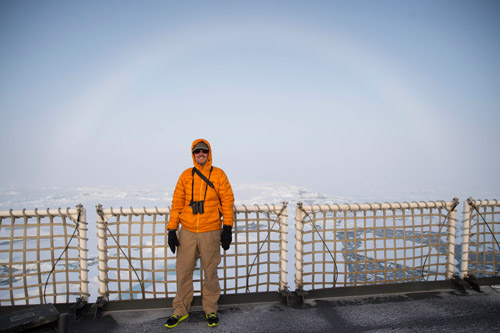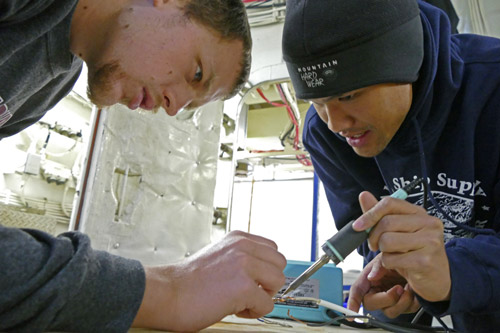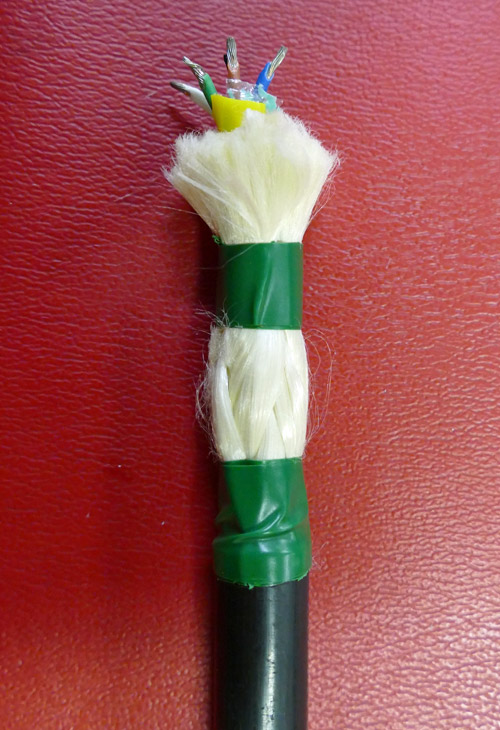Cruise Day 26
Speed 7 knots (kts)
Course 10° N
Location Makarov Basin, approx. 97nm S. of the North Pole
Depth 4003 m
GO DEEPER DISCUSSION:
(see previous journal for the questions.)
Fogbows and rainbows happen when sunlight hits water droplets. Due to surface tension, water droplets falling in the air will become spherical (not the rain-drop shape of cartoons.) These spherical water droplets act as lenses, with light entering a droplet first refracting (changing direction), then reflecting off the inside back of the droplet, and then refracting one more time as it leaves the droplet. Since red light refracts less than purple, a spectrum of spread-out light (you know Roy G. Biv…) is produced in a rainbow. While this can be happening in many directions, the only light you can observe doing this has to come from straight behind you in order for the returning light angle to form the arched rainbow. (For example, if light was coming from your right, you wouldn’t be able to see the rainbow, but someone standing in that direction could see one.)
A fogbow works the same way, but results from the presence extremely small water droplets (less than 0.05 mm.) This allows another optical phenomenon, diffraction, to dominate, blending back the colors into an essentially white bow, though the outer edge can have a reddish his and the inner side a bluish tinge.

TODAY’S JOURNAL:
We’re off the super station, crunching our way north again. After drifting back into the western hemisphere on the last station, we’ve once again made the leap over the International Dateline into the eastern hemisphere. Sometimes we’ve experienced pressure ridges stopping the ship- in this case the Healy backs up, gets another running start, and rams the ridge again. Sometimes once is enough, while the tougher ones mike take several attempts. The toughest one I saw today took five rams, but we were running on 2 engines to save fuel at the time. After that we went to 3 engines, and needed a lot less backing and ramming to maintain our northward progress. In the afternoon snow began falling lightly, coinciding with an encounter with two Canadian icebreakers, the CCGS Louis S. St. Laurent and the CCGS Terry Fox. They were breaking their way back south from their own polar expedition with the larger Louis leading the way. It was pretty cool to see the ships for a couple of reasons. First, we hadn’t seen any sign of humanity off the Healy since the C-130 cargo drop on August 19 (Friends in High Places journal.) Secondly, when I sailed aboard Healy in 2010 (Read here about my 2010 PolarTREC Expedition), the Louis teamed up with us for our Arctic Ocean mapping expedition. It was a daily companion about a mile behind Healy, and I got to tour the Canadian vessel via an exciting helicopter flight over from Healy, and later in the day flew back home again on the Canadian Coast Guard helicopter that Louis carried.


During our super station, the special GEOTRACES conducting cable was damaged while recovering the rosette. Since GEOTRACES is measuring very minute amount of trace metals, the cable has no metal in contact with the water. To be ready for the next station, Greg Cutter and Kyle McQuiggan (graduate student at Old Dominion University, Virginia and GEOTRACES Marine Technician) set out to re-terminate the cable. This means they had to cut away the damaged section, re-connect the inner copper conducting wires that bring power to the instruments on the rosette and return data during the cast, and make a new strong connection to the rosette. This process is known as re-terminating the cable (a termination is an end of something.)

Re-terminating a Vectran cable is a bit different than doing so with a typical steel cable. First, Greg used an impressive set of cutters to slice through the tough cable. The thick outer polyester cover encases very durable Vectran fibers (similar to Kevlar used in bullet-proof vests.) Kyle then fished out the 4 copper wires in the core (these, in their own wire insulation and polyurethane core jacket, never get exposed to sea water) and stripped them back enough to splice into the rosette’s CTDA research tool that is submerged in the water to measure conductivity (salinity), temperature, and depth. connection wires. To strengthen the splice, he soldered the twisted wires together with the help of Joseph Gum, SCRIPPS Marine Technician.


The exposed wires were made waterproof with the application of a special rubber-like coating that is painted on but hardens into a pliable wire-insulating cover. This gets further armored with electrical tape and thick rubber tape before a final coat of the paint-on wire insulation. Finally, a cable-gripping device made of four flat woven Vectran fibers is braided around the end of the cable a bit beyond the electrical splice. Once snug, the cable-gripper grabs and holds it in the fashion of a so-called toy “Chinese finger trap”, drawing tighter around the cable as tension on it increases. The end of the cable-gripper has a loop in it from which the heavy rosette is suspended, since the electrical connection at the end of the cable isn’t made to bear weight. Finally, with the help of a Coast Guard Marine Science Technician the newly terminated cable is stress-tested to about 1.5 tons to check the system before it is re-deployed (a full rosette comes in at about half that weight.) It is pretty neat to see that even a significant problem like the damaged rosette cable can be addressed when we’re out in the middle of nowhere, less than 100 nautical miles from the North Pole.

GO DEEPER!
With even minor course deviations from due north, our Longitude changes very quickly these days while the Latitude continues to tick by gradually. Why are we experiencing this phenomenon?
Aloft Con web cam updated every hour
Healy Track
That's all for now. Best- Bill


Comments